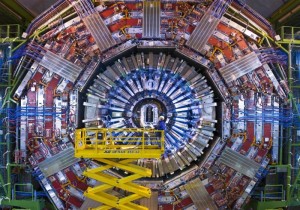CERN’s Large Hadron Collider Returning to Service

 On February 14, 2013, CERNs’ large hadron collider (LHC) executed a maintenance shutdown following ground-breaking experiments that ultimately observed the elusive Higgs Boson particle the year before. It’s now two years later and the facility is being brought back online; it is currently undergoing “warm-up” testing prior to returning to full service.
On February 14, 2013, CERNs’ large hadron collider (LHC) executed a maintenance shutdown following ground-breaking experiments that ultimately observed the elusive Higgs Boson particle the year before. It’s now two years later and the facility is being brought back online; it is currently undergoing “warm-up” testing prior to returning to full service.
Unlike the shutdown performed in response to a wiring fault in 2008, this maintenance period was planned well in advance. The LHC has a virtually countless number of individual parts, including 1232 superconducting, helium-cooled magnets. Statistically, every nut, bolt, and widget has a predictable lifetime and must be replaced prior to the possibility of failure.
When the LHC is brought up to full capacity later this month, upgrades performed during the shutdown should empower researchers to break new ground in the study of particle physics. The improved magnets that keep high-speed protons on track, and the vacuum chamber through which they move, are estimated to support 13 TeraElectronVolt (TeV) collisions at start up, improved from the 8 TeV collisions that produced observable evidence of the Higgs boson. Engineers are predicting they will be able to increase performance even further – up to 14 TeV.
These higher energy collisions are needed to test some fundamental hypotheses, such as supersymmetry — a prediction that every particle exists with a second partner particle. Evidence of supersymmetry is scarce, but the improved LHC may provide an opportunity to more closely observe particle decay after very high energy collisions, perhaps leading to insights about its existence. The higher energy collisions are also predicted to produce more exotic and elusive particles, which may indicate the composition of dark matter, a substance that does not emit any detectable light from the electromagnetic spectrum, but whose gravitational effects can be observed on a galactic scale.
Unlike the Higgs boson experiments, these experiments are exploratory; firm predictions like the existence of a specific particle don’t apply. What CERN may find could be wholly unexpected, and it is that potential for a new discovery that keeps them pushing the limits of the LHC.
